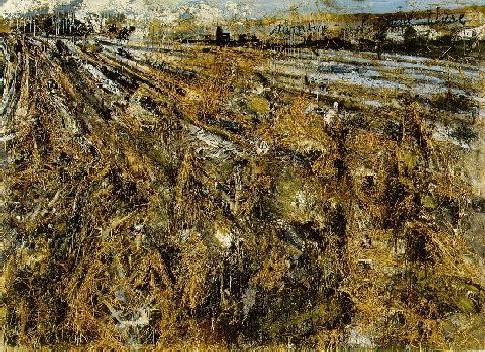Anselm Kiefer


His work includes the usage of: straw, ash, clay, lead, and shellac. The poems of Paul Celan played a role in developing Kiefer’s themes of German history and the horror of the Holocaust. His entire work argues with the past and taboo and controversial issues of recent
Note on the artist:
Kiefer was born in Donaueschingen, Germany on March 8, 1945. In 1951 he moved to Ottersdorf and attended grammar school in Rastatt. In 1966 he left law and Romance language studies at University of Freiburg to study at art academies in Freiburg, Karlsruhe, and Düsseldorf. In Karlsruhe, he studied under Peter Dreher, an important realist and figurative painter. Kiefer began his career as a photographer with performances in which he mimicked the Nazi salute calling for Germans to remember and to acknowledge the loss to their culture through the mad xenophobia of the Third Reich. In 1969 at Galerie am Kaiserplatz, Karlsruhe, he presented his first single exhibition “Besetzungen (Occupations)” with a series of photographs about controversial political actions.
By 1970 while studying under Joseph Beuys in Düsseldorf Kunstakademie, his stylistic leanings resembled Georg Baselitz’ approach. He worked with glass, straw, wood and plant parts. The use of these materials meant that his art works became temporary and fragile, which Kiefer himself is well aware of. The fragility of his work contrasts with the stark subject matter in his paintings. This use of familiar materials to express ideas was influenced by Joseph Beuys’ art practice, in which Beuys used fat and carpet felt. It is also typical of the Neo-Expressionist style.
In the 1970s he incorporated German mythology (see also: Jonathan Meese) in particular, and in the following decade he argued with the Kabbalah. He went on expanded journeys throughout Europe, USA and the middle east, in which the latter two journeys further influenced zhis work. Besides paintings, Kiefer created sculptures, watercolors, woodcuts, photographs and books.
By the 1980s, Kiefer’s themes widened from a focus on Germany’s role in civilization to the fate of art and culture in general. His work became more sculptural and involved not only national identity and collective memory, but also occult symbolism, theology and mysticism. The theme of all the work is the trauma experienced by entire societies, and the continual rebirth and renewal in life.
In 1990 he was awarded a Wolf Prize. In 1999 the Japan Art Association awarded him the Praemium Imperiale for his lifetime achievements. In the explanatory statement it reads:
“A complex critical engagement with history runs through Anselm Kiefer’s work. His paintings as well as the sculptures of Georg Baselitz created an uproar at the 1980 Venice Biennale: the viewers had to decide whether the apparent Nazi motifs were meant ironically or whether the works were meant to convey actual fascist ideas. Kiefer worked with the conviction that art could heal a traumatized nation and a vexed, divided world. He created epic paintings on giant canvases that called up the history of German culture with the help of depictions of figures such as Richard Wagner or Goethe, thus continuing the historical tradition of painting as a medium of addressing the world. Only a few contemporary artists have such a pronounced sense of art’s duty to engage the past and the ethical questions of the present, and are in the position to express the possibility of the absolution of guilt through human effort.”